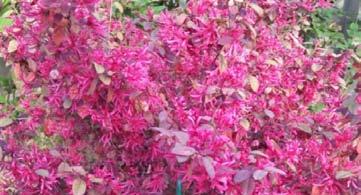
2 minute read
Loropetalum Chinense A Superb Flowering Shrub
Loropeta um chinense A Superb Flowering Shrub
Loropetalum plants are native to Japan, China and Himalayas. Loropetalum chinense commonly known as Chinese fringe flower takes its name from the Greek word ‘loron’ meaning strap, and ‘petalon’ meaning petal belongs to family Hamamelidaceae. Its blooms are similar to those of its close relative witchhazel, with bunches of slender strap-shaped petals forming into tassel-like bursts of colour. Loropetalum are small shrubs. The exotic blooms and the deep, rich burgundy foliage make this plant an eye-catching addition to home gardens. Their flowers are spider like and white in the true species. The flower cymes are around ¾ in across and appear in profusion. Blooms appear in March to April and last for up to two weeks on the stems. The cultivars grown have reddish or pinkish purple flowers and are scented. The odd flower can appear in the nursery on these slightly odd shrubs at any time of the year. The contrast or complementary between the red or purple foliage and the flowers makes for a pleasing effect. This can be even more dramatic in L. Chinense ‘Daybreak’s Flame’.
Advertisement
The planting of Loropetalum chinense is usually in fall, but if purchased in a pot or container, you can plant
in spring or summer while avoiding frost spells and days of intense heat. Loropetalum are best grown in partial shade with wind protection in fertile soil with plenty of compost added. They detest being waterlogged in a boggy area and are tolerant of drought once established. A layer of mulch around their root zones will help reduce competitive weeds and conserve moisture. Ultimately they may achieve 4-6 feet in height with a similar spread but this takes quite a time. It is better to regard them as low mounded — Dr. Raiz Ahmed Lone Scientist, Floriculture and Landscape Architecture KVK, Kupwara, SKUAST-K
semi groundcover shrubs at first. Chinese fringe plants may be pruned to keep them in shape. Remove dead/dry wood regularly, especially at the end of summer. If you must balance or reduce the branches, it’s rather better to wait for the blooming to end. In spring, a light application of slow-release fertilizer will enhance the plant’s health.
When it’s hot watering is needed on a regular basis for Loropetalum chinense and during the first two years after planting. In winter, if it really doesn’t rain and the ground is dry, water during the daytime and never in the evening when it isn’t freezing to ensure you’ll have proper blooming. In summer, always favour watering in the evening to keep water from evaporating.
Loropetalums can be planted in clusters and used as hedges, low screens, espaliers, border edging, foundation plantings, woodland gardens and containers. It is often recommended to thorny, red barberry shrubs and also as an alternative to azaleas for sunny areas, where azaleas can poorly perform.
Loropetalum chinense is particularly hardy to the cold, so growing it in pots is all the more possible with following precautions, v Ensure proper drainage. v Fill the pot in with good soil mix. v Provide fertilizer once a year. v Water regularly because plants in pots need water more often.
Semi-ripe new growth cuttings will root quickly with bottom heat. Loropetalum chinense is perfectly suited for small garden as its growth is very slow and even when it matures it is still quite small. It is also quite invulnerable to diseases and parasites which make it an easy tree to care for. n










